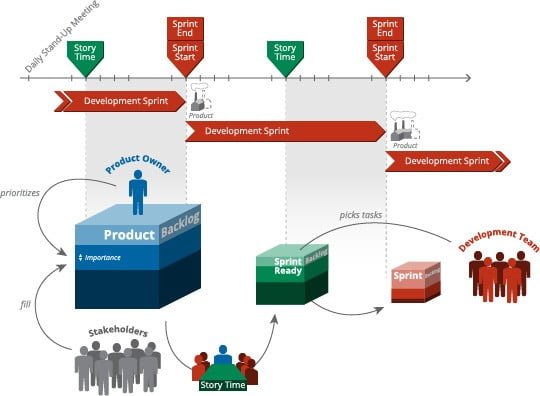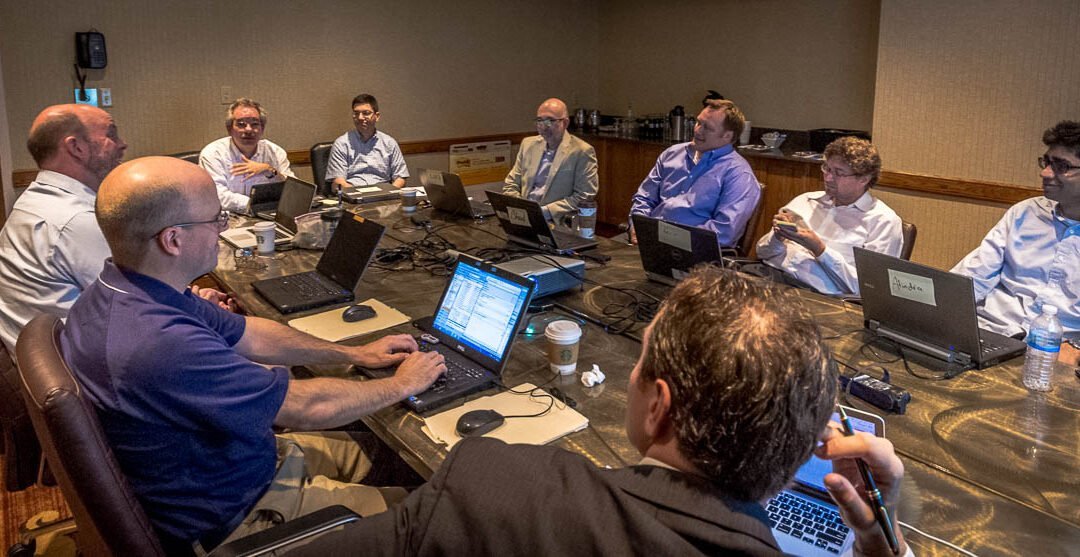
Agile Methodology, Customer Experience, Nearshore, Product Development
Common Myths & Misconceptions for Distributed Agile Teams in Software Development
Throughout this series, we have explored some of the best practices for agile-scrum teams, but in the light of distributed team situations. Scio provides software development teams – working from our development center in Morelia – for projects throughout North America. Our practices, methodologies, and culture are tuned to distributed team situations in a nearshore deployment. We discuss the realities of outsourcing and distributed teams with our prospects and clients on a regular basis. As we wrap up this series, let’s discuss some of the common myths and misconceptions that we hear about frequently.
There is no additional overhead for projects using distributed teams for agile-scrum projects.
Reality: Shared vision, communication, strong procedures, and planning are part of the required overhead for working smart in a distributed team environment. But, the truth is – these same elements should be part of any software development project to ensure success. While a distributed environment requires more rigor and attention to details, all projects benefit from addressing these issues.
More specification must be done at the start of a distributed team project
Reality: Increasing the upfront development of specifications for an agile-scrum project creates a false sense of security and understanding. When something needs to change, there will be latent resistance. There is an increased focus for the full team on understanding where the team(s) are and assuring knowledge is shared – but that should be a normal part of communication in any situation.
Distributed teams cannot do agile and scrum
Reality: If teams are able to organize independently, are cross-functional, collaborative, etc. – there is an overhead in coordination between teams (scrum of scrums) but mitigation in the form of improved awareness of the state of tasks can keep it to a minimum. It is much better to spend resources on coordination than fixes because one team went off the track, wasting time and resources.
Distributed teams have lower quality, more redo’s
Reality: If teams are cross-functional, managing their own tasks and backlog, enabled to work directly with the product owners, have a full development environment using test-driven development, continuous integration and practice regular builds on the central repository for the project, a great number of problems can be avoided. Regular team-wide meetings for planning, pruning, technical issues are overhead, but they will lower impediments greatly if done with openness and trust.
In larger projects, it is better to work as one team than two or more smaller teams even if some members are not co-located with the majority of team members
Reality: The communication and planning overhead does not go down in one larger team in comparison to two or more smaller teams, it rises. Size matters – smaller, self-organizing teams are more efficient overall. Team members in a larger team have less push to be individually responsible and to participate actively in the project. They can easily «hide» in the larger team. In larger teams, the overhead for work review actually climbs, because of the number of people who have to be informed and communicated with. And if the «larger team» is composed of remote members without properly recognizing them as distributed teams or single outside team members – the adherence to standard methodology, processes and assurance procedures tends to drop dramatically. They are literally «out of sight, out of mind.»
There are a lot more things that could be said, but the bottom line is – best practices matter in all agile-scrum projects. Agile is not a license to operate without structure – quite the opposite. It depends on individual responsibility, communication, and adherence to the processes and methodologies adopted by the project team. Agile is adaptive. It will scale along with scrum to situations with distributed teams. Teams that adopt the practices and procedures necessary to be successful in distributed situations as a part of their regular work patterns will have better results in all situations.
We hope this series has been useful and informative for you – helping you to understand what is «behind the curtain» in successful projects and some of the lessons we have learned in the field. If you have a project that you believe could benefit from a team that understands how to leverage agile and scrum in a nearshore implementation, don’t hesitate to contact us.

Agile Methodology, Customer Experience, Nearshore, Project Management
Organizational & Team Best Practices
In the previous article in this series, we started exploring the general organizational and team best practices for agile-scrum projects. In this article, we’re going to finish up a few basic issues and then move into points for distributed teams specifically.
As we have said, the main issue to be considered for software development with agile-scrum teams is communication. If communication is in any way blocked or stifled by cultural or organizational constraints, the team and the project will suffer. In a very real way, knowing how far along the work is on a given user story is part of that communication. We discussed building the technical elements of a system for test-driven development and continuous integration for projects, but there is an organizational element too. Team members must feel these tools are a part of their obligation to their team. They must use them religiously and fully to ensure the tools are doing the job of maintaining code and the development process for all team members. Here a few simple rules to live by:
- All development team members should check work into the common code base as frequently as possible.
- Automated, continuous builds should be run hourly with full logs turned on.
- Each individual team member must exchange a clean build by the end of their shift. Avoid situations where an individual is allowed to push multiple builds outside team core hours that could take planned work or tasks off course.
- If a specific development issue is to be addressed outside of core hours by developers, ensure the scope, limitations, and boundaries are clearly negotiated with everyone and adhered to.
Distributed Team Best Practices

When a software development project is based on distributed teams, some specific organizational practices need to be considered. It isn’t enough to just set up groups in a couple of places, and expect everything to work like it did when you were all sitting in the same big room and able to just turn around and see your teammate.
The first point to consider is how each distributed team in the project will work. One common practice is to put all the QA (as an example) in one team and to have another team be just developers. The problem is – when locations are role-based, they tend to lose overall team collaboration and become an island to themselves. The tendency in this situation is to move to an «us against them» mentality. To avoid this, set up fully cross-functional teams that have their own user stories and backlog. It promotes the team and individual responsibility and gives them a clear role in the project as a whole.
With that in mind, there are a few additional points to consider:
- Use feature-based, rather than component or layer-based teams because it ensures teams continue to have a feeling of being integrated with other teams with shared vision and knowledge. It also allows them to be more flexible if the project changes. They can take on a different backlog because they understand where the project is going.
 Distribute work evenly – don’t allow one team to sit fallow while another catches up. This, of course, implies that regular discussions of workload (a scrum of scrums), dependencies, and assumptions is critical to the balance on the project as a whole.
Distribute work evenly – don’t allow one team to sit fallow while another catches up. This, of course, implies that regular discussions of workload (a scrum of scrums), dependencies, and assumptions is critical to the balance on the project as a whole.- When a team has a local «proxy» for the client-side product owner, it is critical that that proxy role has daily contact and communication with the core product owner to assure they can make decisions quickly and with the assurance they are in sync with the current vision.
- Each team must feel enabled to clarify issues directly with the client side (they have their own user stories – remember…) and not be tied to a chain of notification. Invariably, notification chains shorten messages, misunderstand the context, and create communication loops that just slow down clarification and decisions.
- Teams must have daily points of contact between them (scrum of scrums again) to discuss progress, dependencies, impediments, etc. and assure product owners are not being quarried about the same issues multiple times.
One Team Member «Outside»
There are times when it is necessary to have one lone team member outside the main development group or even a couple of individuals remotely located by themselves. This is not an unusual situation, but it is one that takes care to handle properly. All the work you do to assure a cohesive, collaborative team can be lost when one remote member is not paying their role and participating in the process properly.
In basic terms, all the distributed team and organizational best practices apply except:
- Single development team members cannot be a stand-alone unit in the same way a minimal team can – so they need to be formally paired with other team members in a way that assures they will remain «in the loop» throughout the project. To make this work, consider pair programming (especially early in the project) and pairing with a specific QA.
- Avoid situations where single team members are outside of the team core hours more by more than one or two hours. Longer isolation will simply assure they will not integrate easily with the rest of the team – they will remain the lone wolf on the outside you have to watch constantly to assure they don’t go off course.
- «Standard practices» (development environment, burndown chart, shared repositories, active participation in meetings, communication systems, etc. become critical resources to assure the remote team member feels they are a fully integrated and vital part of the project. All aspects of processes must be proven, clearly documented and relatively easy to setup and use.
- If the remote team member is new to your procedures and processes, have a standard initiation program as a part of the project initiation or before. The program should include not just the setup, practices and methodologies necessary to understand the way the team will operate. It should also include the reasoning and expectations they as a team member will operate under.
The single team member working remotely deserves some special consideration. They must feel they are part of the organization and able to be productive in their environment. For that reason, it is important to consider if they are working from their home, what kind of set up they have. Do they have good networking? Do they have a regular work area with good ventilation, light, and isolation from distractions? A worker at home, with the TV blaring in the other room or perhaps a baby that requires attention on a regular basis is going to find it very difficult to be as productive as their teammates. What can you do to assure they are not at a disadvantage? Consider issues in the same way you would any impediment in agile development – what can you do to move the impediment out of their way?
The Take-Away
In the end, it should be easy to see that that making an agile-scrum project successful with distributed teams is nothing more than doubling down on the best practices that are an integral part of agile. If they were important in a team in a single location, they are doubly important in a distributed team and have even more impact on project outcomes. Does a distributed team model immediately burden a project with additional overhead? Well, we will discuss this aspect more in the last article in this series, but the simple answer is no. If you have been using best practices for agile-scrum projects religiously – a project with distributed teams just requires a little more focus and diligence. If you were not as judicious as you should be about your practices, then yes, there will be overhead because your risk of failure will be much higher for distributed teams until you get your practices in line.
In our last article in this series, we will explore common myths that crop up whenever anyone proposes any level of distributed teams in software development. Remember, as a nearshore software development provider, these are objections we discuss with potential clients regularly. So join us – won’t you?
If you jumped into the middle of this series, you can go back to the start here.

Agile Methodology, Customer Experience, Nearshore, Product Development, Project Management
Organizational and Team Best Practices
While it might seem that adopting the agile-scrum framework to distributed teams is all about the right tools (especially if you read marketing materials from tool makers), in general, it is more about how you organize your teams and processes than anything else. For that reason, we decided to break this part of the discussion into two sections. Our assumption is you are only going to read so much during your breaks between meetings, on your smartphone….
Project Initiation
 There are all sorts of reasons that a «kick-off» meeting is critical for project success, in fact, we’ve already talked about a few in the earlier posts from this series. But in this part of the series, we’re focusing on the organizational elements of a successful agile-scrum software development team.
There are all sorts of reasons that a «kick-off» meeting is critical for project success, in fact, we’ve already talked about a few in the earlier posts from this series. But in this part of the series, we’re focusing on the organizational elements of a successful agile-scrum software development team.
One of the areas that are especially important is the cohesion and understanding between the individual members of the team. If it is not taken care of the upfront, it can take a long time to build. If you are not aware of the teaming model developed by Bruce Tuckman, this is a good time to start considering it. In short, Mr. Tuckman found that teams follow a regular pattern of «storming, norming and performing» during their lifecycle. If you can shorten this cycle and get too strong performance sooner, you are better off. We have found that kickoffs that include games, team-building, and participative events go a long way to achieving this goal. In fact, for longer projects, planning similar events around specific milestones prevents teams from going back through the cycle later in the process.
There are many guides available for these activities, but regardless of which ones you find useful, the actual activities are not something you can simply jump into and do from a book. It takes practice and experience to successfully integrate team activities into project initiation so the sooner you start using them the better. We have found teaming model to be an excellent resource, but again, it requires some hands-on experience to use successfully.
What do you need to do to assure success for project initiation meetings?
- Include as many team members as possible in a single location, even if some must travel greater distances. The time and expense will pay off handsomely in the end.
- If some team members or teams cannot attend, arrange parallel events that the teams can report on or share in an online conference format (voice, video, photos, etc.).
- Sync your agile – scrum processes, artifacts, and ceremonies across teams and participants with actual sessions during the joint event. Execute sprints if possible (use Sprint 0 as a base). Set expectations with everyone that the processes will be standardized and adhered to across the entire team.
- Establish a shared product vision with presentations, question/answer sessions, product games, etc.
- Agree on core project hours for the entire team (including product owners, proxies, etc.) and communication standards. Core hours should overlap considering the time zones involved. Ensure everyone commits to core hours and provides proxies if they cannot be reached.
- Agree to set regular meetings during core hours even if not everyone expects to be in the meetings. This assures if questions come up during the meetings, they can be quickly answered.
- Agree on timing for sprint planning, retrospectives, and other planning activities. The more standardized the timing for these meetings, the more likely they will be to be integrated into individual routines.
- Learn and respect cultural viewpoints across the team, festivals, language preferences. Plan to share status around holidays, common activities, etc.
- Encourage an atmosphere of fun, respect, and collaboration.
This is a lot to accomplish in any timeframe, much less a day or a few hours. Project kickoffs must be carefully planned and managed. They could and often should take more than a day. We’ve had initial meetings, including initial work, take as long as a week. Once you have dealt with them to and from aspects of the travel, the rest is relatively inexpensive – so don’t push to shorten the time more than necessary.
Best Practices for All Scenarios

Planning component breakdown during the kickoff.
We’ve said that part of making agile-scrum for distributed teams successful is including many of the necessary best practices in all projects, not just the ones with distributed members. These best practices are critical for distributed teams, but also just good practice in any software development project. Your distributed teams will «catch on» quicker if these are part of your regular practice and adapt to new situations better.
- Participation by every individual in the team in meetings is always important. That said, it isn’t natural for everyone. Team members must be positively coached to engage in active, personal participation. Avoiding situations where one person becomes the de facto spokesman for the team helps to ensure team members don’t sit back and not contribute. Trust is an important element in participation. Team members must feel comfortable questioning ideas and playing devil’s advocate when necessary to draw out concepts and beliefs. Each team member must feel enabled to speak directly with the client/project team to avoid forming communication chains that will inevitably muddle and shorten their message.
- Plan frequent live demos and retrospectives with time for questions and clarifications. Communication in these meetings should not be more tightly time-bound than necessary, but when long conversations do surface, don’t be shy about moving them to a parking lot to be addressed in a specific meeting meant to resolve that issue with the right people involved.
- Scrum masters should be careful to practice servant-leadership roles. They need to concentrate on removing impediments so tasks can move forward rather than prescribing how tasks should be done.
- Pre-plan a larger window of future sprints on a weekly basis (depends on the length of sprints) specifically to expose interdependencies between teams, roles, etc. and groom backlogs with the team as a whole.
- Lean to short sprints rather than long and synchronize/prioritize between teams regularly. Avoid situations where a team could go too far down a path before syncing with others.
- Have irregular, casual «brown-bag» sessions to discuss technical alignment, decisions and common ground among members and teams.
- Find ways to rotate team members. Rotation can be between locations, roles, among teams, etc. Don’t allow individuals to become insular units by themselves or with specific team members. Accomplishing this goal can be challenging, but it is especially important in longer projects. Rotation should not be «one way» (always to the client site for instance) and where it isn’t possible, consider remote pairing too as an alternative.
Granted, these points are not easy to accomplish. They take planning and practice to get right – but the aim is to ensure a successful project and enough cannot be said about how much of success is preparation. The next installment in this series will continue to explore organizational and team issues, there is a lot to cover. We will also cover issues related to specific scenarios that we have found take a slightly different approach. I hope you will stay with us to see how important it is to understand software development projects in an agile-scrum environment and learn more about what is needed to extend it to distributed teams.
If you are coming in the middle and want to jump back to the start of the series, you can start here. Or if you are looking for a software development partner and want to contact us, just click here and leave us a message and we will be contacting you ASAP.

Customer Experience, Nearshore, Outsourced Engineering Team
With the continuous rise of smart technology, it is only natural for company owners and managers to find ways of incorporating software development into their respective businesses. After all, software engineering is the core foundation of the web and mobile apps that connect and cultivate the modern customer’s loyalty to the brand.
Why outsource your software development projects
Although US businesses have the advantage of operating in the tech capital of the world, the majority of US companies choose to outsource software development to another country. Outsourcing saves time and effort in finding and hiring a professional that can do the job well. It is also likely to be more cost-effective. In 2015, more than 470,000 IT jobs were outsourced from the US to other countries such as Mexico, India, and Ukraine.
Aside from price and quality, one must also consider the cultural compatibility of the outsourcing firm to your business process or model. Business cultural compatibility can help break several barriers (e.g. language) that usually accompany cross-border associations.
Cultural compatibility: Which one matches your business?
If you are thinking of outsourcing software development to either Mexico, India, or Ukraine, here are the things you need to know:
Mexico
1. Their business culture is heavily influenced by the US
A large number of US multi-national companies operating in the country might have something to do with how Mexico structures its business models and processes. Unlike their American counterparts, however, Mexicans tend to favor personal relationships rather than individual skills. This means you need to personally gain their trust first before they will allow you to conduct significant business with them.
2. Their management style is paternalistic
Managers tend to treat subordinates like family. Nevertheless, this does not mean they cannot impose severe punishment towards a wayward employee. They just like to combine an authoritative approach with certain familial warmth. This creates a deep sense of loyalty between the manager and the employees.
3. Business meetings in Mexico present an opportunity to exchange information and free-flow ideas
If you are the type of person to strictly follow the agenda in a business meeting, you might feel frustrated in a meeting with a Mexican business partner. On the bright side, you’ll go home teeming with excellent ideas to keep your business ahead of the curve. The more active and animated a Mexican is in a meeting, the more you are guaranteed that he/she is committed to doing good business with you.
India
4. They are strongly guided by religious and cultural beliefs
As with most countries in Asia, religion and tradition play a big part in doing business in India. For example, you should never use your left hand to shake hands or offer/accept things, as they believe that the left hand is unclean.
5. Their business core value is family-oriented
Indians are strongly family- and community-oriented. One must first establish a personal connection before they will be open to do business with you. Meetings would often begin with personal questions about each other’s families. It is also expected that business partners spend a lot of time interacting through dinners and social clubs to build good relationships with each other.
6. Regular contacts and face-to-face meetings are the keys to a fruitful business relationship in India
Building personal relationships is important when conducting business in India. Unfortunately, you can’t build a good personal relationship purely by phone or email. You need to take frequent trips and meet face-to-face with your Indian counterpart if you want to ensure the success of your business collaboration.
Ukraine
7. Ukrainians have a flexible concept of work hours
In Ukraine, the concept of time is directly linked to the person’s hierarchical status in the office. A manager may arrive five to 20 minutes later than expected. Even with appointments made in advance, it is considered polite to call a day to confirm the actual meeting.
8. Ukraine acknowledges both personal relationships and individual skills when hiring new people
While people with personal connections to managers might have a slight edge during the hiring process, Ukraine’s business culture compels decision-makers to also put the individual’s skills and expertise into consideration. They are known to express their delight and/or disappointment openly, regardless of whether it is a personal or professional relationship.
9. Ukrainians are masters in multi-tasking
If your Ukrainian counterpart starts to take phone calls or read emails in the middle of a conversation or a meeting, don’t be offended. They are not trying to be rude, but they are trying to show how efficient they are in their work by doing multiple things at the same time.
10. Whether it’s Mexico, India, or Ukraine, it is advisable to schedule a meeting coinciding with lunch breaks.
Lunch break is already a lengthy affair, so it is also the best time to discuss business concerns. It does not hurt that there is a warm, hearty meal in front of everyone to improve the mood. Lunch meetings are the best way to establish camaraderie and know your business partner better both professionally and personally.
Looking for a suitable software development company?
Traveling halfway across the globe to outsource your software development project can be a hassle. To avoid this, choose us, our development centers are located in Morelia, Michoacan, Mexico.
With us, you don’t have to worry about travel expenses or managing fast-moving projects as you’ll be able to collaborate with Mexico-based team members in real time. This is the true agility of nearshore software development. Contact us now and experience better cultural compatibility and alignment in your business.

Customer Experience, Outsourced Engineering Team, Successful Outsourcing
No matter who you are and what culture you were raised in, hearing the word “no” can be downright devastating. After all, the word is commonly associated with utter failure and defeat. There are various reasons why people say ”no” to you. However, your words and actions after the rejection can make a world of difference, especially in the business field.
What “no” really means
Most entrepreneurs dread getting a negative answer. It does not matter whether the rejection comes from a supplier, business partner, or client.
Just imagine: if saying or hearing the word “no” can cause great conflicts within a workplace, how much more damage can it do when it is used in a business deal between different cultures? People who don’t share the same language, social, and economic backgrounds are sometimes bound to misunderstand each other.
However, “no” can mean differently in each culture. While it can initially be perceived as a negative response, it may also just be an opening for a new idea or starting point. In this case, cultural competence becomes the key to handling “no,” regardless of where it comes from.
How different cultures handle rejection
Modern technological advancements have made it possible for entrepreneurs to reach potential clients and business partners across the globe. Indeed, it is very rare to find a workplace that is not highly diversified as a result of this globalization.
However, this cultural diversity in a workplace can be a source of conflict among the employees and the managers. This is especially true if there is persistent resistance to accommodate certain values and beliefs of other cultures.
Nevertheless, being aware of the different cultures is not enough to thrive in the world of business. It is also essential to understand where each culture is coming from. Here are some of the most common cultures that you might see in the workplace.
Americans
Americans tend to be straightforward and speak their minds directly. They prefer the discussions to be straight to the point. They also prefer to speak directly to all parties involved rather than ask a third party to send the message for them.
For this reason, whenever an American hears the word “no,” he or she is keen to hear the exact reasons for the rejection. For them, it is quite usual to dish out and hears both positive and negative feedback since these appeals to their high sense of individualism. This is not to say that Americans are not afraid of confrontations. They just tend to be more vocal about their thoughts and feelings.
Indians
With approximately 4.8 million people in the workforce, India holds the second largest number of workers in the world, there is a big chance that you will meet more than one Indian colleague in the workplace.
Since India is composed of different cultures, languages, and religions, it can be difficult to find the right approach in business dealings. For the most part, having a flexible approach works when interacting with an Indian colleague in the workplace.
However, Indians place a high value on respecting authority figures in the office. For example, it is considered rude to greet a younger colleague first before a senior one. It is also essential to appropriately address people by their respective titles (e.g., Doctor, Professor, etc.)
Like workers from other Asian countries, Indians avoid getting into verbal confrontations with their colleagues. As a result, the way they communicate can be frustrating, especially when they are conversing with a person from a different culture (i.e., Americans). Indians prefer indirect or circular communication. More than verbal, there is a need to watch out for gestures, facial expressions, and other cues to understand what they truly mean.
For them, the phrases “I understand,” “Maybe we can try that,” or “Yes, but…” may not exactly mean that they are agreeing with your idea or suggestion. However, directly disagreeing or saying “no” can be perceived as downright impolite or shameful. Thus, when they are in the receiving end of a direct rejection, they tend to take offense and get more critical about themselves.
Mexicans
In terms of cultural competence, Mexicans are right on top of the food chain. Due to their large numbers and relatively young age (compared to other employees in an ordinary American company), they are more accepting of any cultural shift in the workplace.
Thus, the way they handle rejections can be considered as a curious mix between the American and the Asian approaches. While they are not shy in accepting both positive and negative feedback, they are wary of public confrontations.
Hence, unlike their American counterparts who have no problem airing their grievances in an open forum, Mexicans might take offense if you reject them openly in front of their co-workers. In this case, the best way to give a rejection or constructive criticism to a Mexican employee is to isolate them from the pack and talk to them privately.
Get Scio
Any business person should know that hearing the word “no” is not the endgame as each culture takes rejection differently. Our technical and industry expertise is only compounded by our highly skilled, dynamic, and diverse culture that understands how to handle and work around that initial “no” from a client. Need to develop products that would get instant approval from clients around the globe? Contact us, and get to know some of the Top Houston Software Developers

Agile Methodology, Customer Experience, Mobile, Nearshore, Outsourced Engineering Team, Product Development, Technologies
When building any kind of company, there are steps you must take that will do the most to ensure your success. These steps are especially lucrative when building a company that works for other companies such as the ever-growing industry of software-as-a-service. It may be difficult to know on your own what are some of the ways you can ensure success in your software service company. To make it simpler for you, we have compiled a couple of the ways that you can see to it that your company has the best shot of success.
Keep it simple
Because software is often self-serve it is best to keep it simple and easy to use considering the majority of business owners aren’t computer geniuses. Making it more user-friendly will mean that more people will want to use your software for their business. Keep it simple, tidy, and user-friendly.
Never stop improving
O ne way that a lot of software service companies fail is that they become complacent with their software. A good software service company listens to their customers and continuously improves and updates its product to make it work even better and smoother. Monitoring what the consumer is saying allows the software service company to cut out unnecessary functionality which ties into the “Keep it simple” rule.
ne way that a lot of software service companies fail is that they become complacent with their software. A good software service company listens to their customers and continuously improves and updates its product to make it work even better and smoother. Monitoring what the consumer is saying allows the software service company to cut out unnecessary functionality which ties into the “Keep it simple” rule.
Offer several different packages
You should always have more than one package available where the first and lowest functioning one is basically free. From there you can increase the price per software based on customer needs, usability, willingness to pay, and ROI.
Display a path to profitability
Oftentimes a company will not be profitable simply because they invest their resources to sustain growth. Good service software companies must show that they plan to be profitable in the next few years and that they have a path to profitability. The best way for a company to achieve this is to hit profitability every couple of years before reinvesting.
Offer the perfect mix of services
 Offering the right amount of services can be difficult for a company but it is highly lucrative to the success of a said company. On one hand, they increase revenue and reduce churn rates whereas on the other hand they reduce margin and increase deployment time and cost of sales.
Offering the right amount of services can be difficult for a company but it is highly lucrative to the success of a said company. On one hand, they increase revenue and reduce churn rates whereas on the other hand they reduce margin and increase deployment time and cost of sales.
Commit to the success of your customer
One of the most important things to remember when growing a software service company is to sign new customers as well as commit to grow and secure its recurring revenue from previously signed customers. To accomplish this, the company must be monitoring its customer’s usage levels continuously as well as send them customer satisfaction surveys and product updates among other things.
These are just a few of the major points to remember when you are trying to build a successful and profitable software service company. Along with these, you will find that you discover things that work for your company and your specific product and what does not.
Are you ready to develop your App?
Click here and schedule a meeting
Scio provides end-to-end engineering services in a collaborative partnership to ensure that your team is an integral part of the solutions you require. We can offer a wide range of skills to make up a team that you can depend on – and work with directly. And when you need something more – we’re flexible. From helping to assess your needs to developing, implementing and maintaining solutions, we can offer as much or as little help as you need. Our teams can work with you virtually or on your site – but most companies need some type of combination of the two and we’re more than happy to find that blend too. If you think that sounds interesting – Contact Us. We’re ready.




 Distribute work evenly – don’t allow one team to sit fallow while another catches up. This, of course, implies that regular discussions of workload (a scrum of scrums), dependencies, and assumptions is critical to the balance on the project as a whole.
Distribute work evenly – don’t allow one team to sit fallow while another catches up. This, of course, implies that regular discussions of workload (a scrum of scrums), dependencies, and assumptions is critical to the balance on the project as a whole.
 There are all sorts of reasons that a «kick-off» meeting is critical for project success, in fact, we’ve already talked about a few in the earlier posts from this series. But in this part of the series, we’re focusing on the organizational elements of a successful agile-scrum software development team.
There are all sorts of reasons that a «kick-off» meeting is critical for project success, in fact, we’ve already talked about a few in the earlier posts from this series. But in this part of the series, we’re focusing on the organizational elements of a successful agile-scrum software development team.




